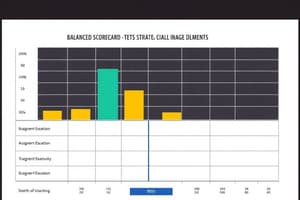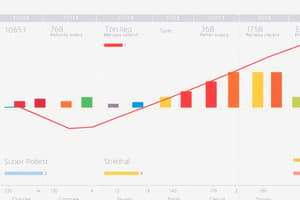Podcast
Questions and Answers
What is the primary purpose of the balanced scorecard?
What is the primary purpose of the balanced scorecard?
- To solely focus on customer satisfaction
- To provide a comprehensive view of business performance (correct)
- To enforce strict hierarchical management
- To measure short-term profits exclusively
Which of the following is NOT one of the four perspectives of the balanced scorecard?
Which of the following is NOT one of the four perspectives of the balanced scorecard?
- Supplier perspective (correct)
- Learning & Growth perspective
- Customer perspective
- Financial perspective
How does the balanced scorecard help organizations implement their strategy?
How does the balanced scorecard help organizations implement their strategy?
- By promoting individual achievements over team objectives
- By enforcing strict guidelines on employee conduct
- By translating vision into operational goals and linking it to performance (correct)
- By focusing solely on financial metrics
What are strategic initiatives in the balanced scorecard?
What are strategic initiatives in the balanced scorecard?
What does the term 'strategy map' refer to in the context of the balanced scorecard?
What does the term 'strategy map' refer to in the context of the balanced scorecard?
Which of the following is an important element in the integrated business planning process?
Which of the following is an important element in the integrated business planning process?
What type of measures does the financial perspective focus on within the balanced scorecard?
What type of measures does the financial perspective focus on within the balanced scorecard?
Which of the following processes is crucial for implementing the balanced scorecard?
Which of the following processes is crucial for implementing the balanced scorecard?
What is a major drawback of financial figures mentioned in the content?
What is a major drawback of financial figures mentioned in the content?
Which perspective measures the performance of key business processes?
Which perspective measures the performance of key business processes?
What is recommended when creating measures for organizational performance?
What is recommended when creating measures for organizational performance?
Which of the following outcomes can result from implementing a new telephone system?
Which of the following outcomes can result from implementing a new telephone system?
How can organizations utilize the Balanced Scorecard?
How can organizations utilize the Balanced Scorecard?
What does the Learning and Growth Perspective measure?
What does the Learning and Growth Perspective measure?
What effect does separating strategy creation from strategy implementation have in organizations?
What effect does separating strategy creation from strategy implementation have in organizations?
What common phrase is used to describe the correlation between measuring performance and organizational outcomes?
What common phrase is used to describe the correlation between measuring performance and organizational outcomes?
What is the primary focus of the Balanced Scorecard?
What is the primary focus of the Balanced Scorecard?
How do traditional financial reports primarily function?
How do traditional financial reports primarily function?
Which perspective in the Balanced Scorecard emphasizes customer acquisition and satisfaction?
Which perspective in the Balanced Scorecard emphasizes customer acquisition and satisfaction?
Which of the following is NOT an element of the Balanced Scorecard's Business Processes perspective?
Which of the following is NOT an element of the Balanced Scorecard's Business Processes perspective?
What aspect is included in the Learning & Growth Perspective of the Balanced Scorecard?
What aspect is included in the Learning & Growth Perspective of the Balanced Scorecard?
What question aligns with the customer perspective in the Balanced Scorecard?
What question aligns with the customer perspective in the Balanced Scorecard?
Which of the following perspectives in the Balanced Scorecard addresses fiscal obligations?
Which of the following perspectives in the Balanced Scorecard addresses fiscal obligations?
What is a key inquiry of the Internal Perspective of the Balanced Scorecard?
What is a key inquiry of the Internal Perspective of the Balanced Scorecard?
What is the primary reason for needing a Balanced Scorecard (BSC)?
What is the primary reason for needing a Balanced Scorecard (BSC)?
Which barrier indicates that the workforce lacks understanding of the business strategy?
Which barrier indicates that the workforce lacks understanding of the business strategy?
What is emphasized as essential for implementing a Balanced Scorecard?
What is emphasized as essential for implementing a Balanced Scorecard?
Which of the following is NOT one of the 10 Golden Rules for implementing a BSC?
Which of the following is NOT one of the 10 Golden Rules for implementing a BSC?
What common issue do most executive teams face when discussing strategy?
What common issue do most executive teams face when discussing strategy?
What is the main focus of today's management systems according to the content?
What is the main focus of today's management systems according to the content?
How many objectives and measures should businesses focus on according to the Golden Rules?
How many objectives and measures should businesses focus on according to the Golden Rules?
What is primarily used to drive an organization's strategy?
What is primarily used to drive an organization's strategy?
Which of the following is NOT a focus area of the Balanced Scorecard?
Which of the following is NOT a focus area of the Balanced Scorecard?
What is a strategy for improving stability in revenue growth?
What is a strategy for improving stability in revenue growth?
How does the Balanced Scorecard help non-profit and government organizations?
How does the Balanced Scorecard help non-profit and government organizations?
What is essential for satisfying customers and financial donors in the Balanced Scorecard?
What is essential for satisfying customers and financial donors in the Balanced Scorecard?
Which strategy focuses on improving operating efficiency?
Which strategy focuses on improving operating efficiency?
What is a purpose of the Learning Perspective in the Balanced Scorecard?
What is a purpose of the Learning Perspective in the Balanced Scorecard?
Which of the following strategies does NOT pertain to the Productivity Strategy?
Which of the following strategies does NOT pertain to the Productivity Strategy?
What must organizations do to achieve their vision according to the Balanced Scorecard?
What must organizations do to achieve their vision according to the Balanced Scorecard?
Which is an example of what the Internal Perspective focuses on?
Which is an example of what the Internal Perspective focuses on?
What is a key feature of the Balanced Scorecard framework?
What is a key feature of the Balanced Scorecard framework?
What should organizations develop according to the Learning Perspective?
What should organizations develop according to the Learning Perspective?
Which objective correlates with increasing customer confidence in the Balanced Scorecard?
Which objective correlates with increasing customer confidence in the Balanced Scorecard?
What does the 'Improving Returns' objective focus on?
What does the 'Improving Returns' objective focus on?
Flashcards are hidden until you start studying
Study Notes
What is the Balanced Scorecard?
-
The Balanced Scorecard (BSC) is a strategic management system that helps organizations achieve their vision and translate it into action.
-
It is a comprehensive approach that goes beyond traditional financial metrics to include customer, internal process, and learning and growth perspectives.
BSC Implementation
-
Implementing a BSC typically involves four key processes:
-
Translating the vision into operational goals: This includes defining specific, measurable, achievable, relevant, and time-bound (SMART) goals.
-
Communicating the vision and linking it to individual performance: This ensures that everyone in the organization understands the strategy and is motivated to contribute.
-
Business planning: This involves developing a detailed plan that aligns with the strategic objectives and identifies the necessary resources, timelines, and responsibilities.
-
Feedback and learning: This includes regularly monitoring progress, identifying areas for improvement, and adjusting the strategy accordingly.
-
BSC Components:
-
Strategy map: A tool that visually represents the strategic objectives and the cause-and-effect relationships between them across four perspectives.
-
Strategic objectives: Smaller, specific goals that contribute to the overall strategy.
-
Measures: Quantifiable metrics that track the progress toward achieving the strategic objectives.
-
Strategic initiatives: Actions and projects that drive the desired changes and advancements defined by the strategic objectives.
BSC Four Perspectives:
-
Financial perspective: Measures that reflect the financial performance of the organization (e.g., return on investment, cash flow).
-
Customer perspective: Measures that focus on customer satisfaction and loyalty (e.g., customer surveys, complaint rates).
-
Internal business perspective: Measures that evaluate the effectiveness of key business processes (e.g., time to process orders, unit defect rates).
-
Learning and growth perspective: Measures that assess the organization's ability to learn and adapt (e.g., employee training hours, employee satisfaction).
Benefits of using a Balanced Scorecard:
-
Clarifies strategy and aligns efforts: Ensures everyone in the organization is working towards the same goals.
-
Provides a comprehensive view of performance: Goes beyond traditional financial metrics to provide a holistic picture of the organization's performance.
-
Facilitates communication and accountability: Helps managers communicate strategy effectively and hold individuals accountable for their performance.
-
Improves strategic decision-making: Provides data-driven insights that inform strategic decisions and enable better resource allocation.
-
Drives continuous improvement: Encourages organizations to constantly evaluate their performance and make adjustments to their strategies based on feedback.
Adaptable to Diverse Organizations:
- The BSC framework can be tailored to various organizations, including non-profit and government organizations with mission-driven objectives.
Addressing Barriers to Strategic Implementation:
-
The BSC can help overcome common barriers to strategy implementation:
-
Vision barrier: Ensure everyone understands the strategy.
-
People barrier: Align incentives with strategic objectives.
-
Management barrier: Dedicate time and resources to strategy discussion.
-
Resource barrier: Allocate resources effectively to support strategic initiatives.
-
Golden Rules for Implementing a BSC:
-
No standard solutions: Tailor the BSC to your organization's specific needs.
-
Top management support: Ensure leaders are committed to the BSC.
-
Strategy as the starting point: Develop a clear vision and strategy before implementing the BSC.
-
Limited and balanced objectives and measures: Focus on a few critical areas.
-
Iterative approach: Refine the BSC based on feedback and experience.
-
Bottom-up and top-down approach: Involve all levels of the organization in the BSC process.
-
Systems are an issue: Consider existing systems and how they can support the BSC.
-
Evaluate delivery systems: Assess how to effectively communicate and implement the BSC.
-
Consider behavioral implications: Ensure that performance indicators motivate desired behaviors.
-
Not all measures can be quantified: Recognize that some aspects of the BSC may be difficult to quantify.
Studying That Suits You
Use AI to generate personalized quizzes and flashcards to suit your learning preferences.




